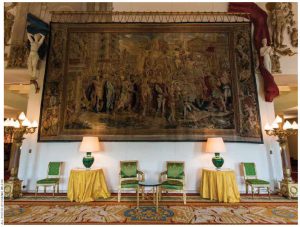
French Ambassador Phillipe Zeller and his wife, Odile, live in one of the most opulent and beautifully situated embassies in the nation’s capital — a granite edifice built on an escarpment above the Ottawa River.
The French government bought the property from Arthur Blackburn in 1931 for $80,000 and in 1936, prime minister William Lyon Mackenzie King laid the cornerstone. French architect Eugène Beaudouin, builders and hand-picked French artists spent two and a half years working at the site before the embassy opened its doors in 1939.
The best Canadian and French materials were used in the construction, including Canadian wood for the doors and door frames, gray granite from Quebec for the exterior façade and French green marble for the floors. The newspapers of the day wrote glowing reviews. Ottawa was bowled over by its grandeur.
Designed in art deco style, the residence has tall windows looking out into the large park-like garden towards Sussex Drive, a sign of its openness to the world. Huge windows along the back wall face the river and Quebec.
There is symbolism everywhere, including its prime location next to Rideau Falls, which were named in 1613 by French explorer Samuel Champlain. The building is filled with historical references to France’s influence in Canada and pays homage to the highest expression of French culture, shown in its art, tapestries and furniture.
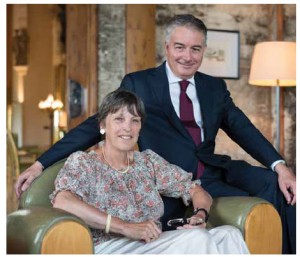
Ambassador Zeller says that he is always discovering something interesting in his residence. From the Gobelins tapestry in the grand hall to the intricacies of the birch bark room; from his office with its pen-and-ink etchings on the wall to the quaint and colourful scenes of Happy France in the dining room. It takes a book put out by the embassy to explore all the building’s marvels and treasures.
“This embassy is one of the prettiest and the most beautiful we have around the world,” Mr. Zeller says. “There are around 150 embassies, but this one is really interesting, built when Canada decided to open its first embassy in Paris, so we decided to open one in Ottawa and we decided in spite of the economic crisis of that time, to build a really beautiful building to celebrate, of course, the Canadian troops of World War I and the history of France and Canada.”
At one point in his career, Ambassador Zeller was in charge of managing all of France’s diplomatic real estate, “so I knew that it was a splendid residence,” he says. “When you begin to live in this building, you find many things.”
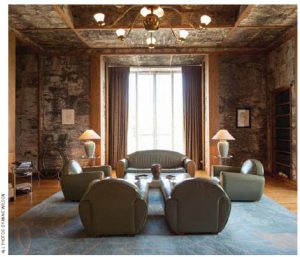
When the couple arrived in August 2011, they observed many interesting architectural and design elements right away, but he says more than a year later, they are still finding details in painting and carving.
Entering the building from the west side entrance, one is overwhelmed by the sheer size of the French travertine walls in the entrance hall, and the huge windows that rise up to the second-floor gallery, providing a view of the garden and Sussex Drive. Comfortable tables and chairs surround French doors and three eye-catching Aubusson tapestries representing spring in Paris, summer in Brittany and winter in the Alps hang on the high walls. Another, showing autumn in Flanders, decorates the ambassador’s private suite.
A sweeping pink marble staircase leads upward to the gallery where, opposite a long pink marble bench, is a reproduction of the Vimy Ridge Memorial commemorating the famous First World War battle won by Canadian troops on French soil, in 1917.
At the west end of the hall are two fascinating rooms. The first is the ambassador’s office. Ten panels of stone engravings by French artist Charles Pinson tell the story of New France, from an opening scene of an Aboriginal dance and continuing through to the end of the Battle of Quebec.
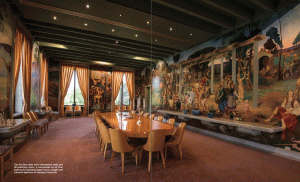
The artist developed a technique of “smooth cut engraving on stone” and his work includes scenes of the French period of discovery to Jacques Cartier and his companions carrying their banner to the new land. The arrival of wives to Quebec is detailed, as is the founding of Montreal. Samuel de Champlain and his wife appear, as does an image of a young lady wearing a dress with the music of a famous song embroidered on it. It refers to links with Saint-Malo. Recently, Gen. Charles Bouchard, the Canadian general who led the NATO operations in Libya, visited the embassy and when he saw the song engraved on the wall, he began to sing it.
“It emphasizes the history of France and Canada’s close links of nearly 400 years. Next year, we hope to celebrate Champlain. He went to Ottawa in 1613 and his statue is on Nepean Point, a hill overlooking the Ottawa River. It would be a good thing to have some celebrations on the river and on its bank,” he says, because the embassy’s is a symbolic location on the side of the river and it offered a magnificent view to Quebec.
The small smoking room next to the office, known as the Birch Room, has a charming fireplace with the walls and ceiling completely covered in birch bark with red cedar panelling and pillars. It was considered by Beaudouin, the architect, to be the most original piece of the project.
“The birch bark is a salute to the forest on the other side of the river,” says the ambassador. The 1930s-style leather furniture in the Birch Room was made in Paris, while the woven carpet was inspired by a drawing by André Masson.
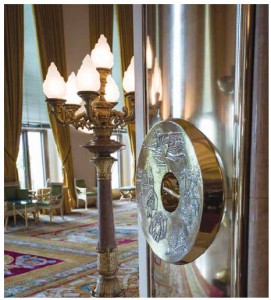
In the centre of the second floor is the grand salon, which opens from the hallway and marble bench through two sets of magnificent bronze doors with engraved door pulls. The medallions are delicately engraved with four major themes: labour, family, faith and remembrance.
The magnificent salon is dominated by a priceless Gobelins tapestry called The Triumph of Constantine, woven in the 17th Century from a Raphael drawing.
The walls are also adorned with sculptures of Adam and Eve, Profane Love and Sacred Love as well as a frieze of horses. Yellow damask curtains outline immense windows looking out over the river, the colour matching the yellow in the breathtaking Savonnerie carpet that the Duchesse de Berry used in the Tuilleries. It was rescued from a fire at the Palais de Tuileries in 1871.
At the east end of the grand salon is the more casual round sitting room, where the ambassador can host small, informal meetings and meals, while guests enjoy the view and the intricate, more modern furnishings. Three terracotta panels have different themes. The first, over the fireplace, depicts the battle of Roncevaux in 778, while the second is dedicated to Louis XV and his various exploits.
Perhaps the most enchanting space is the dining room. The Art Deco-style inlaid cherrywood table and 38 matching chairs, is surrounded on all four walls by the painting Happy France, a bright and colourful depiction of everyday French life. Painted on plaster in social realism style by artist Alfred Courmes, the work took one year to complete and was controversial from the start. The painting depicts 243 characters in “joyous” France at the time of the first paid holidays and at the time of the Second World War.

The story goes that in the 1950s, a clergyman, while eating his dinner, looked at the wall in front of him and was horrified by the sight of naked children on the beach and what he thought were the suggestive poses of several women in the painting. He demanded that work be removed from public view.
The ambassador at the time, who liked the painting but felt it might be “more appropriate in a party room in the city hall of Cannes or Nice,” had the panels covered by wall hangings and shelving. In 1957, the walls were covered over with three coats of paint on top of sheets of canvas stretched over the frame and painted white.
Happily in 1982, delicate restoration work began to uncover the original and restore the paint. Two years later, friends and guests gathered in the dining room for a festive party around La France Heureuse, to celebrate “the end of a disgrace,” as described in Ottawa, Ambassade de France, a lush coffee-table book published as part of a series featuring French embassies around the world.
Away from public view, the ambassador and his wife have private quarters on the third floor with wonderful views and an elegant guest suite, suitable for the most prestigious visitors.
To the embassy’s credit, most of the original furnishings, including examples of the best of 20th-Century French contemporary furniture created expressly for the residence, have been preserved and protected.
Each July 14, Bastille Day, the embassy throws a giant garden party where more than 2,000 guests enjoy French cheeses and wines under large tents on the front lawn. Considered one of the premier events of the diplomatic social season, it’s also a chance for many in the Ottawa community to get up close and personal with one the most interesting of all the city’s diplomatic residences.
Margo Roston is Diplomat’s culture editor.





